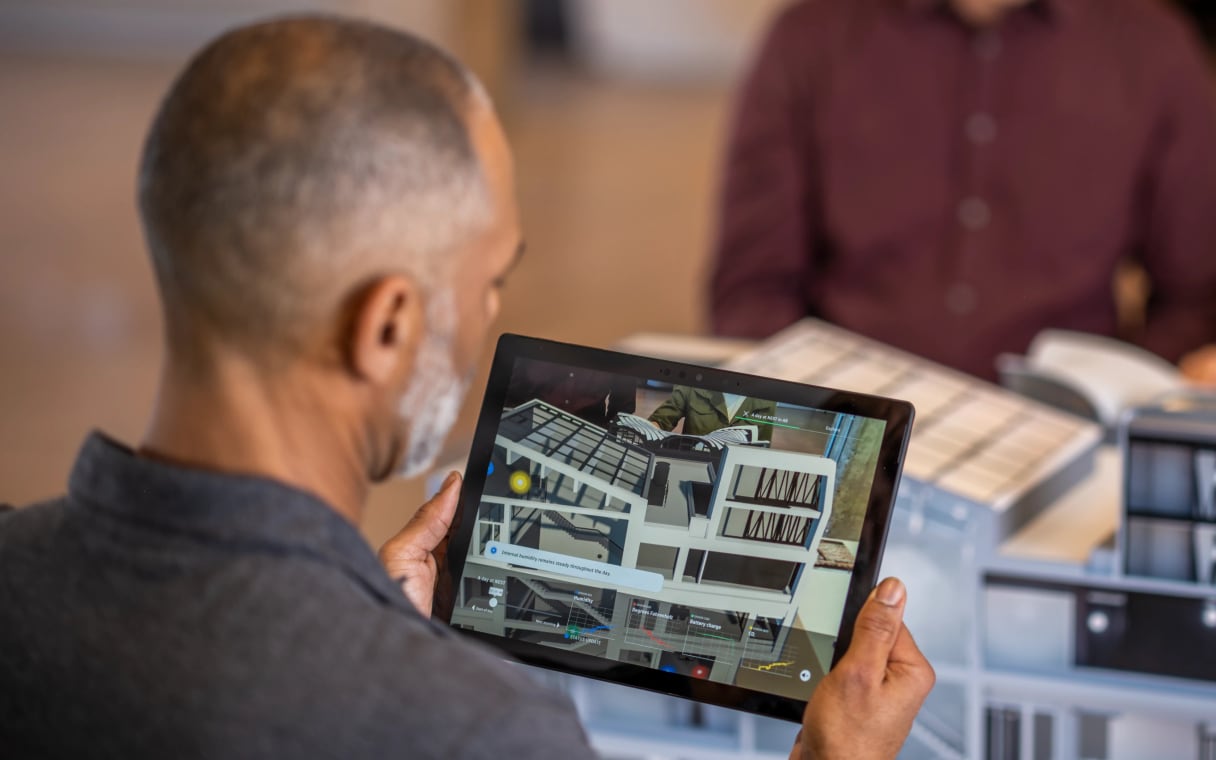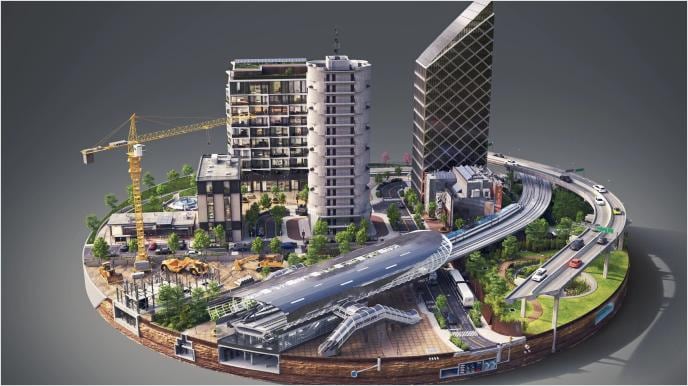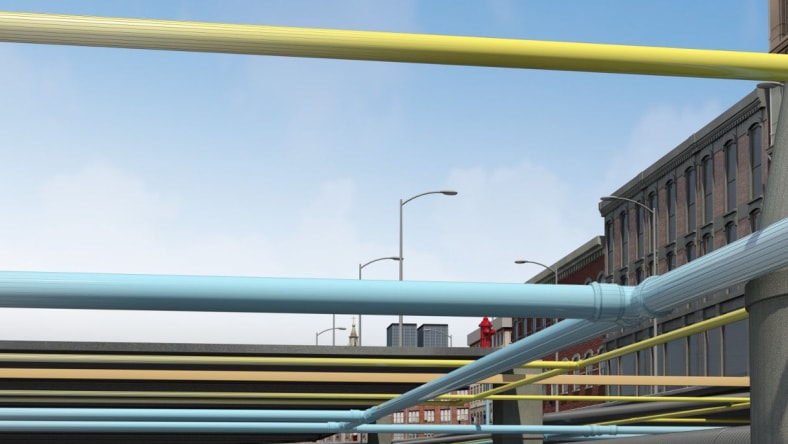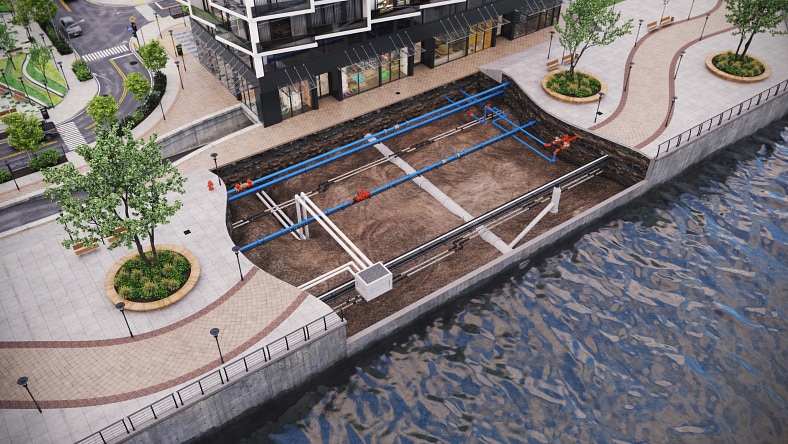& Construction

Integrated BIM tools, including Revit, AutoCAD, and Civil 3D
& Manufacturing

Professional CAD/CAM tools built on Inventor and AutoCAD
Challenges like aging infrastructure, grid modernization, climate change, regulatory compliance, and handling vast amounts of data can strain the resources of electric utility providers. What’s needed are advanced software solutions that enhance reliability, efficiency, and safety—and prepare utilities for the continued evolution of the energy sector.
Autodesk solutions include robust infrastructure design and management tools, integrated GIS capabilities, real-time monitoring and analytics, asset management throughout the lifecycle, and support for sustainability initiatives. They also make it easier for you to collaborate, ensuring seamless communication and coordination across projects.
Get more efficient land development workflows, interoperability, and collaboration. Great productivity leads to improvements in design quality.
Become more collaborative and digitally mature. Stay on the forefront, with the most up-to-date revisions, resources, and workflow capabilities.
Collaborative workflows with multiple disciplines lead to fewer field change requests and model rework. Gain more accurate models throughout the project lifecycle.
Enhance your electric utility operations with Autodesk Vault, the premier data management solution designed to streamline workflows, improve collaboration, and ensure data integrity. Vault helps power utility providers efficiently manage and secure their design and engineering data, from initial concept through maintenance and upgrades.
Connect people, data, and processes across the project lifecycle in a cloud-based, common data environment. Expand beyond the office; work together anytime, anywhere. With transparent workflows, you can reduce distractions and errors, and increase capacity. And with a centralized source of truth, you can eliminate siloes, improve access to data, generate insights, and enjoy complete oversight.
Realize the full potential of your power utility projects with the BIM (Building Information Modeling) process. Designed to meet the unique needs of the electric utility sector, Autodesk's BIM software offer a comprehensive, intelligent, and collaborative platform for planning, designing, constructing, and managing infrastructure.
Digital twins in the utility sector create virtual representations of physical assets and systems, integrating real-time data from sensors and IoT devices to optimize operations and predict maintenance needs. This technology enhances grid reliability, operational efficiency, and resilience by providing a comprehensive, data-driven view of utility infrastructure. Leaders in the industry use digital twins to improve service quality, reduce downtime, and manage renewable energy integration.
The utilities sector in the United States has been experiencing a digital transformation for the past decade. Utilities have transformed daily administrative and some business operations, but still have a long way to go in digitizing the infrastructure lifecycle. Read this e-book to learn how Autodesk is helping the utility industry digitize.
Powerful BIM and CAD tools for designers, engineers, and contractors, including Revit, AutoCAD, Civil 3D, Autodesk Forma, and more
Cloud-based design co-authoring, collaboration, and coordination software for architecture, engineering, and construction teams. “Pro” enables anytime, anywhere collaboration in Revit, Civil 3D, and AutoCAD Plant 3D.
Comprehensive field and project management software that delivers a broad, deep, and connected set of tools for builders.
WEBINAR
Revit® is used to design, document, and deliver building and infrastructure projects, Twinmotion compliments the process by keeping pace with real-time rendering of design and build efforts.
PARTNER OVERVIEW
Autodesk and Esri, the industry's leading supplier of GIS software and applications, have partnered to transform infrastructure project workflows. Our strategic alliance bridges BIM and GIS, placing critical data at the center of projects.
WEBINAR
This webinar discusses how Autodesk Workshop XR can take model coordination further by creating Autodesk Construction Cloud issues in the VR environment.
Electric utility professionals use software for various functions including digital 3D modeling for network simulation, workforce and crew management, and field and asset optimization. They also rely on platforms for managing communication networks and geographic information systems (GIS) for asset management and field operations. Additionally, software for electrical system design, distribution, transmission, operation, and automation is essential, often integrated with digital twin technology. Tools for monitoring equipment health, supporting asset performance management, and assessing environmental processes like waste reduction are also commonly used. These solutions enhance operational efficiency, reliability, and compliance in the power utility sector.
If embraced, digital transformation can significantly enhance the power utility sector. For example, it can help power providers improve efficiency, reliability, and customer service. With advanced data analytics, it’s much easier to forecast demand and manage grids. Real-time monitoring and automation streamline operations, reducing downtime and maintenance costs, and enhanced cybersecurity measures protect critical infrastructure.
ESRI is a leader in Geographic Information System (GIS) modeling and mapping software and technology. Autodesk and ESRI integration enables the seamless flow of data between GIS and BIM, which helps electric utilities providers better plan, design, manage, and optimize their infrastructure.
Cloud technology is used extensively in the electric utility industry to enhance efficiency, scalability, and data management. It enables real-time data collection and analysis from smart meters and sensors, improving demand forecasting and grid optimization. Cloud platforms support advanced analytics and machine learning for predictive maintenance, reducing equipment failures and downtime. They also facilitate the integration of renewable energy sources by managing and balancing supply and demand. Cloud-based systems enhance cybersecurity by providing robust, scalable security solutions. Moreover, customer-facing applications hosted on the cloud offer personalized insights and services, improving customer engagement and satisfaction.
Autodesk software can significantly optimize power utility operations through various advanced tools and functionalities:
Design and planning: Autodesk's design software, such as AutoCAD and Revit, assists in creating precise electrical infrastructure layouts, enhancing planning accuracy and efficiency.
BIM integration: Building Information Modeling (BIM) tools like Revit facilitate detailed 3D modeling and simulation of electrical systems, improving project visualization and coordination.
Asset management: Autodesk tools help in creating comprehensive digital twins of physical assets, enabling better monitoring, maintenance, and management of utility infrastructure.
Collaboration: Cloud-based solutions like Autodesk Construction Cloud allow for seamless collaboration among teams, ensuring all stakeholders have access to the latest project data and updates.
Workflow automation: Automation tools streamline repetitive tasks, reduce errors, and free up resources for more strategic activities.
Sustainability: Autodesk software supports sustainable design practices by enabling the analysis of environmental impacts and optimizing resource usage.
By using these capabilities, Autodesk software helps power utility companies enhance their operational efficiency, reduce costs, and improve service reliability.
A digital twin is a virtual replica of a physical asset that is updated in real time to represent its live characteristics. It is a virtual reality where power plant engineers can experience and ask what-if questions to simulate scenarios to help them solve problems, train staff, meet challenges, increase efficiency, reduce expenses, and improve service.
For example, power utility plant engineers can use digital twin technology for the following aspects of plant operations and maintenance:
By integrating digital twin technology, power utility plant engineers can achieve more reliable, efficient, and sustainable plant operations.
Electric power transmission and distribution involves the process of transporting electricity from power plants to end-users. Transmission refers to high-voltage transfer over long distances, while distribution involves lower voltage delivery to homes and businesses. This system ensures reliable and efficient access to electricity for various applications.
Autodesk offers several products that can be used to design electric transmission and distribution systems, including:
AutoCAD: For detailed design and drafting of electrical systems
Revit: For building information modeling (BIM) to design and manage infrastructure projects
Civil 3D: For civil engineering design and documentation
InfraWorks: For infrastructure design and planning







